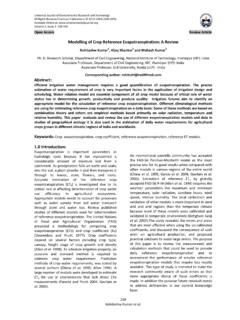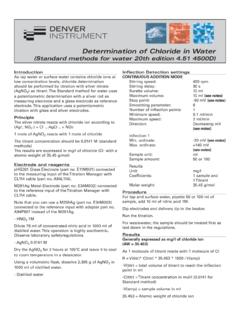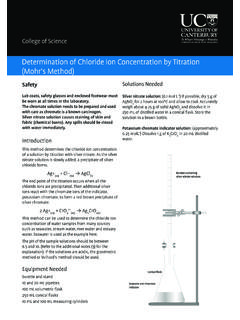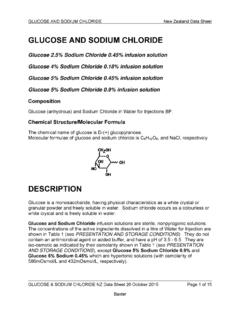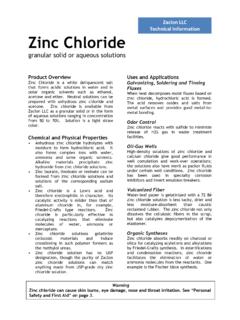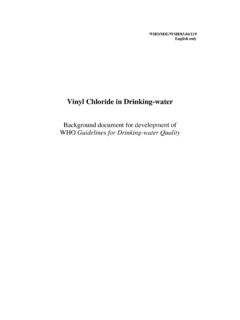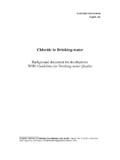Transcription of Chloride Removal from Wastewater by Biosorption …
1 Universal Journal of Environmental Research and Technology All Rights Reserved Euresian Publications 2011 eISSN 2249 0256 Available Online at: Volume 1, Issue 4: 416-422 Open Access Research Article 416 Apte et al. Chloride Removal from Wastewater by Biosorption with the Plant Biomass 1 Apte Sagar. S.; 2 Apte Shruti S., 1 Kore V. S., 1 Kore S. V. 1 Department of Environmental Science and Technology, Department of Technology, Shivaji University, Kolhapur, Maharashtra, India 2 Environmental Science, Shivaji University, Kolhapur, Maharashtra, India Corresponding author: Abstract: Chlorides are the natural substances which are found in the water bodies in varying amounts.
2 However, their concentrations are significantly low. However, the industrial, domestic and agricultural wastewaters that are generated from the human society may contain large amount of chlorides, which can cause significant disruption in the ecological balance. Many techniques have been adopted in order to reduce the amount of chlorides in Wastewater like demineralization, reverse osmosis, coagulation, precipitation, electrodialysis and so on. However, these techniques are physico chemical in nature, and are cost consuming capital cost wise as well as maintenance cost wise.
3 Therefore, the following paper makes an effort towards putting forth a biological alternative for the Removal of chlorides from Wastewater . The present paper studies the suitability of Parthenium sp. as a sorbent for Chloride Removal . Further, variations in the efficiency of Biosorption with respect to different pH, concentration and time were studied. The paper concluded that Parthenium sps. dried biomass is capable of achieving upto 40% reduction in the Chloride content at Lab scale. Keywords: Biosorption , Parthenium, chlorides, Wastewater . Introduction: Chloride is a salt compound resulting from the combination of Chlorine gas and a metal.
4 The common Chloride salts include Sodium Chloride (NaCl), and Magnesium Chloride (MgCl2). Industrial processes such as battery manufacturing, pulp mills, bullion refining, electroplating, pesticide manufacturing, a large number of small scale processing units etc are the main sources of chlorides in water. In majority of these industries, the main source of chlorides in the effluent is the use of Lime (Ca (OH) 2) or Sodium Hydroxide (NaOH) for the neutralization of acidic effluents. At different instances, Acids like Hydrochloric Acid (HCl), or Sodium Hydroxide (NaOH) can be a major part of the industrial processes, where they are used for the initial de-coating of Oil film on the raw material.
5 Naturally, they contribute substantially to the chlorides in Wastewater . The major impact that chlorides impart on the receiving waters is the permanent hardness. They are also known to increase the rate of sedimentation and thereby decreasing the water column depth. When such effluents are disposed on land, chlorides tend to initially percolate some distance, but over a period of time, they cause surface salt formation, thereby causing increased alkalinity of the soil, thereby resulting in loss of soil fertility. In plants, chlorides tend to accumulate in the tissues, especially the leaves.
6 Chloride accumulation in plants is closely related to the chlorine concentration in the external solution and the genotype (Hajrasuliha, 1979). It was also noted that when sodium and Chloride , when supplied via landfill leachate irrigation, is accumulated in high concentrations in the tissues of many plants like Populus (Zalesny 2007) Properties of Chlorides and Impacts: Chlorides are widely distributed in nature as salts of sodium (NaCl), potassium (KCl), and Calcium (CaCl2). Organoleptic Properties: The taste threshold of the Chloride anion in water is dependent on the associated cation.
7 Taste thresholds for sodium Chloride and calcium Chloride in water are in the range 200-300 mg/litre (Zoeteman BCJ., 1980). The taste of coffee is affected if it is made with water containing a Chloride concentration of 400 mg/litre as sodium Chloride or 530 mg/litre as calcium Chloride (Lockhart EE et al, 1955). Environmental fate: Chlorides are leached from various rocks into soil and water by weathering. The Chloride ion is highly mobile and is transported to closed basins or oceans. Universal Journal of Environmental Research and Technology 417 Apte et al. Environmental Levels and Human Exposure: Water: Chloride in surface and groundwater from both natural and anthropogenic sources, such as run-off containing road de-icing salts, the use of inorganic fertilizers, landfill leachates, septic tank effluents, animal feeds, industrial effluents, irrigation drainage, and seawater intrusion in coastal areas (Department of National Health and Welfare, Canada, 1978).
8 Chloride in water may be considerably increased by treatment processes in which chlorine or Chloride is used Food: Chloride occurs naturally in foodstuffs at levels normally less than mg/g. An average intake of 100 mg/day has been reported when a salt-free diet is consumed. However, the addition of salt during processing, cooking, or eating can markedly increase the Chloride level in food, resulting in an average dietary intake of 6 g/day, which may rise to 12 g/day in some cases. Kinetics and Metabolism in Laboratory Animals and Humans: In humans, 88% of Chloride is extracellular and contributes to the osmotic activity of body fluids.
9 The electrolyte balance in the body is maintained by adjusting total dietary intake and by excretion via the kidneys and gastrointestinal tract. Chloride is almost completely absorbed in normal individuals, mostly from the proximal half of the small intestine. Normal fluid loss amounts to about liters/day, together with about 4 g of Chloride per day. Most (90-95%) is excreted in the urine, with minor amounts in faeces (4-8%) and sweat (2%) (Department of National Health and Welfare, Canada, 1978). The oral LD50 values for calcium Chloride , sodium Chloride , and potassium Chloride in the rat have been reported as 1000, 3000, and 2430 mg/Kg of body weight, respectively (WHO report Copenhagen, 1978).
10 The toxicity of Chloride salts depends on the cations present; that of Chloride itself is unknown. Although excessive intake of drinking-water containing sodium Chloride at concentrations above g/liter has been reported to produce hypertension (Fadeeva VK., 1971), this effect is believed to be related to the sodium ion concentration. Effect of Chlorides Human Health: A normal adult human body contains approximately g Chloride . On the basis of a total obligatory loss of Chloride of approximately 530 g/day, a dietary intake for adults of 9 mg of Chloride per kg of body weight has been recommended (equivalent to slightly more than 1 g of table salt per person per day).
